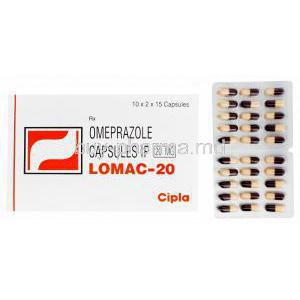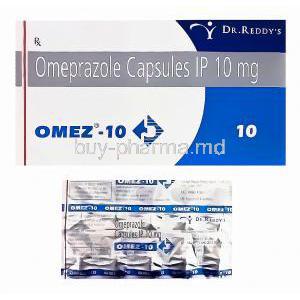Introduction to Omeprazol Relief / Omeprazole
Omeprazol Relief (Omeprazole) is categorized within the proton pump inhibitor (PPI) class, a pharmacotherapeutic category engineered to markedly attenuate gastric acid secretion. It is widely recognized for its potency in reducing intragastric acidity, and for its capacity to promote mucosal restoration in acid-related disorders. It has become a foundational therapy in modern gastroenterology.
OTC versions are commonly positioned for intermittent heartburn and episodic reflux management, while prescription-strength preparations are targeted toward more aggressive disease states, erosive tissue injury, or longer-term suppression objectives.
Chemical Composition and Formulation Details
At a molecular level, omeprazole is a substituted benzimidazole derivative, structurally optimized to target secretory canalicular proton pump units. Its physicochemical profile relies on acid-labile architecture, requiring formulation measures to preserve activity.
- Excipients are selected for chemical stabilization
- Enteric coating technology guards the compound from acid degradation
- Granular matrices retain potency until intestinal release conditions are achieved
Available platforms include delayed release tablets, DR capsules, and oral granules appropriate for suspension preparation. These diversified delivery systems enhance clinical versatility.
Mechanism of Action: How Omeprazol Relief Works
Omeprazole triggers irreversible suppression of the parietal cell H+/K+ ATPase proton pump. This blockade disables final pathway hydrogen ion exchange, reducing basal and stimulated acid output.
Gastric acidity gradually declines as pumps deactivate permanently and require biological replacement. The onset may begin within hours, but maximal steady-state acid control often requires repeated consecutive doses for several days.
Approved Uses and Therapeutic Indications of Omeprazole
Commonly indicated in:
- GERD symptom reduction and mucosal healing
- Acute erosive esophagitis therapy
- Maintenance after epithelial restoration
- Peptic ulcer disease (both gastric and duodenal)
- H. pylori eradication as a core component of triple or quadruple regimens
- Zollinger-Ellison and other hypersecretory pathologies
Longitudinal acid management contributes to epithelial stability and relapse prevention.
Off-Label Uses and Investigational Indications
Clinical practice has evolved beyond conventional labeling. Situations where omeprazole is frequently utilized include:
- Functional dyspepsia symptom reduction
- Barrett’s esophagus acid suppression strategies
- NSAID gastritis or erosion prophylaxis
- Stress ulcer prophylaxis in ventilated ICU cohorts
- Laryngopharyngeal reflux (hoarseness / globus sensation)
- Eosinophilic esophagitis PPI-trial evaluation phase
These indications reflect observational efficacy as opposed to regulatory authorization.
Dosage and Administration Guidelines
Standard adult doses vary from low-dose daily suppression to high-dose divided regimens for hypersecretory disease states. Single daily administration is typical, while twice daily dosing is reserved for refractory persistence.
- Dosing before meals optimizes intraparietal proton pump binding
- Therapy duration may range from short 2-week symptomatic control to chronic maintenance
- Granules may be mixed with non-carbonated liquid for patients unable to swallow intact formulations
Special Population Administration Considerations
Administration to Elderly Patients
The elderly demonstrate higher susceptibility to long-term sequelae including fractures, micronutrient depletion, and renal sensitivity. Dose individualization and periodic reassessment are prudent practice principles.
Administration to Pregnant Women and Nursing Mothers
Omeprazole has documented placental transfer and trace lactational passage. The risk–benefit matrix must be evaluated based on severity, with pharmacovigilance recommended during prolonged gestation or postpartum treatment intervals.
Administration to Children and Adolescents
Pediatric therapy requires calibrated weight-based dosing strategies. Granule/suspension preparations are often preferable for small children or those with dysphagia, ensuring accurate administration while preserving enteric protection.
Side Effects and Adverse Reaction Profile
Common Side Effects
- Headache
- Abdominal discomfort
- Nausea or diarrhea
- Constipation
- Flatulence
- Mild dizziness or fatigue
- Taste alteration events
Serious or Rare Adverse Reactions
- C. difficile associated colitis
- Magnesium depletion with subsequent cramping or arrhythmia risk
- Vitamin B12 malabsorption and anemia
- Bone density decline with long-term exposure
- Acute interstitial nephritis or chronic kidney impairment
Risk stratification intensifies with prolonged therapy duration, concurrent nephrotoxic exposures, and polypharmacy frameworks.
Drug Interactions and Co-Administration Risks
Omeprazole undergoes hepatic biotransformation by the CYP2C19 isoenzyme pathway. This pathway is highly polymorphic, and therefore drug–drug interaction risk is of particular relevance when co-administration patterns are complex. Even minor metabolic inhibition can cause amplified serum levels of susceptible substrates.
- Co-administration with clopidogrel may attenuate antiplatelet effect due to impaired bioconversion to its active thiol metabolite
- Alteration of gastric pH can reduce systemic uptake of azole antifungals and some antiviral agents that require acidic microenvironment for optimal absorption
- Co-administration with warfarin, diazepam, and phenytoin may elevate levels, necessitating vigilance in INR and CNS effect monitoring
Polypharmacy deserves careful assessment, especially in elderly and hepatic impaired individuals.
Warnings, Contraindications, Careful Administration and Important Precautions
Absolute contraindications include documented hypersensitivity to omeprazole or any proton pump inhibitor analog. Past anaphylactoid reactions or cutaneous reaction syndromes serve as a barrier to rechallenge regimens.
Alarm symptoms such as dysphagia, overt bleeding, unexplained anemia, or unexpected weight loss require diagnostic evaluation prior to therapy escalation or continuation. These features may represent underlying malignant pathology or complex ulceration beyond simple acidity control.
- Chronic long-term suppression may be associated with bone mineral density diminution
- Micronutrient deficits such as magnesium or vitamin B12 depletion may emerge silently
- Severe hepatic dysfunction requires dose modulation or alternative selection
These precautions strengthen the rationale for periodic reassessment and optimized individualized care.
Overdose Information and Emergency Management
Omeprazole overdose typically elicits nonspecific gastrointestinal and neurological symptoms such as nausea, tremor, or confusion. Life-threatening deterioration is uncommon but potentiation may occur in individuals exposed to multiple central nervous system depressants.
Emergency management relies upon supportive interventions:
- Airway and cardiovascular surveillance
- Symptomatic emesis control
- Fluid and electrolyte regulation if severe vomiting or diarrhea occurs
Seek urgent emergency attention when severe toxicity, collapse, arrhythmia, or persistent neurological disturbance is observed.
Storage and Handling Precautions
Omeprazole formulations should be preserved within controlled room temperatures to safeguard against degradation. Packaging integrity is fundamental because enteric coatings are designed to bypass acid exposure until intestinal transit.
- Shield from direct illumination due to photolabile chemistry
- Defend from moisture infiltration, which can disrupt the enteric polymer matrix
- Retain in original unit-dose blisters or sealed containers until consumption
Consider shelf-life limitations and keep products beyond the reach of children. A secure and dry environment enhances the product’s stability profile and ensures therapeutic reliability.









